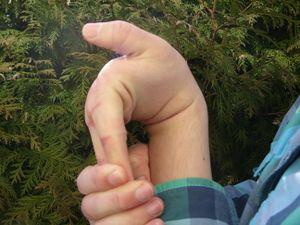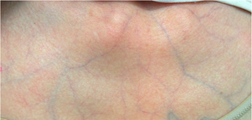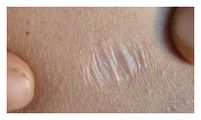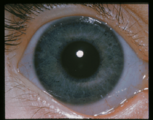Ehlers-Danlos syndrome
Ehlers-Danlos syndromes (EDS) is a group of inherited disorders that affects connective tissues — primarily skin, joints, and blood vessel walls.[1] It is a genetic disease that causes a defect in the production and/or metabolism of collagen and other connective tissue abnormalities.[2][3] It is characterized by joint hypermobility, skin hyperextensibility, and tissue fragility, and ranges widely in severity.[4]
Symptoms and presentation[edit | edit source]

Symptoms vary widely between individuals, based on the subtype of EDS they have. EDS affects connective tissues, which results in symptoms that range from mild joint effects to life-threatening complications.[2]
- joint hypermobility (stretch further than normal)
- loose/unstable joints, prone to subluxations/dislocations
- joint pain
- joints that move beyond the normal range (hyperextensibility)
- early onset of arthritis
- soft, velvety-like skin
- fragile skin that tears or bruises easily
- severe scarring
- slow and poor wound healing
- development of molluscoid psuedo tumors
- musculoskeletal pain
- poor muscle tone (less common)
Subtypes[edit | edit source]
There are currently thirteen sub-types of EDS. These include six distinct types of EDS and sub-types, as well as five presentations that fit into an 'other' category.[5][6][2] They are:
- Hypermobile EDS (hEDS) - the most dominant clinical manifestation; presents with joint hypermobility, resulting into dislocations, bruising and chronic pain, often out of proportion to physical and radiological findings.
- Classical (cEDS) and Classical-like (clEDS) presents with marked skin hyperextensibility, joint hypermobility, and in clEDS easy bruising.
- Vascular EDS (VEDS) and Cardiac-valvular EDS (cvEDS) - presents with arterial/intestinal/uterine fragility with possibility of arterial or organ rupture; often presents with thin or translucent skin with veins being visible thru the skin and in cvEDS severe progressive cardiac-valvular problems.
- Kyphoscoliosis Type - presents with scoliosis, joint laxity, and severe muscle hypotonia at birth; scoliosis is progressive and may result in the loss of the ability to walk in one's 20's or 30's. Other common features include a "marfanoid habitus" characterized by long, slender fingers; unusually long limbs; and a sunken chest or protruding chest.
- Arthrochalasia Type - presents with congenital hip dislocation and generalized joint hypermobility; may also have skin hyperextensibility, tissue fragility, kyphoscoliosis, and muscle hypotonia.
- Dermatosparaxis Type - presents with severe skin fragility and substantial bruising.
- Other Types - Brittle Cornea Syndrome (BCS); Spondylodysplastic EDS (spEDS),Musculocontractural EDS (mcEDS), Myopathic EDS (mEDS), Periodontal EDS (pEDS) - this category groups the rarest genetic presentations sometimes only seen in one family.[5][6]
Prevalence[edit | edit source]
Ehlers-Danlos syndrome affects both males and females.[6]
1 in 5,000 have some form of EDS worldwide.[3] Hypermobile EDS (hEDS) and classical forms of EDS (cEDS) are most common. Hypermobile may affect as many as 1 in 5,000 to 20,000 people, while the classical type probably occurs in 1 in 20,000 to 40,000 people. Other forms are rare, often with only a few cases or affected families in the world.[7]
Risk factors[edit | edit source]
Ehlers-Danlos syndrome is a hereditary disease cause by a genetic mutation in one or more of the connective tissue genes, especially those involved in the metabolism of collagen,[2][3] an important protein found in muscle, skin, ligaments, tendons, cartilage, bones, blood vessels, and other body tissue.[2]
Diagnosis[edit | edit source]
Diagnosis is made through physical examination which includes a test for hypermobility, such as the Beighton Scoring System[8] or the Brighton criteria for EDS.[9]
Pathophysiology[edit | edit source]
EDS is a diverse group of inherited connective-tissue disorders. Joint hypermobility, skin fragility, and hyperextensibility characterize the disorders. Collagen defect has been identified in at least six types.[2]
The vascular form is characterized by a decreased amount of type III collagen. It is autosomal dominant (AD), one parent with a defective gene are needed to pass on this form of EDS and is caused by mutations in COL3A1. This results in increased fragility of connective tissue with arterial, intestinal, and uterine ruptures and premature death.[10]
In EDS types I and II, cEDS and clEDS, causative mutations may involved the COL5A1, COL5A2, and tenascin-X genes and are implied to be in the COL1A2 gene. "Although half of the mutations that cause Ehlers-Danlos syndrome types I and II are likely to affect the COL5A1 gene, a significant portion of the mutations result in low levels of mRNA from the mutant allele as a consequence of nonsense-mediated mRNA decay."[2] [11]
Kyphoscoliotic (type VI) is characterized by generalized joint laxity, skin fragility, and severe muscle hypotonia at birth. It is autosomal recessive (AR), both parents with defective genes are needed to pass on this form of EDS. More than 20 mutations are identified in the LH1 gene that contributes to LH deficiency and clinical EDS type VI.[2][12]
Impaired wound healing is a typical feature of EDS.[2]
Pediatric patients have deficiencies in three genes of glutathione S-transferase family (GSTM1, GSTT1, GSTP1).[2][13]
Reduced activity of beta4GalT-7 is associated with the progeriform (causing children to age rapidly) EDS.[2]
"Biallelic mutations in FKBP14 may result in a recessive form of Ehlers-Danlos syndrome with progressive kyphoscoliosis, myopathy, hearing loss, and, possibly, an increased risk for vascular complications."[2][14]
An EDS Types Chart[15] with AD/AR inheritance pattern (IP), genetic basis, and protein involved are provided by The Ehlers Danlos Society.
Systems affected by EDS[edit | edit source]
Systems affected by EDS include:
- anxiety disorders and depression
- bladder
- bleeding
- brain and spine
- circulatory system, cardiovascular
- dental, oral, and voice problems
- digestive disorders
- diverticulitis
- heart and valve leakage
- hernia
- joint, musculoskeletal
- ocular
- reproductive
- skin
- subluxations and dislocations[16][17][18][19][20][21][22][23][24][25][26][27][28]
Comorbidities & complications[edit | edit source]
ME/CFS[edit | edit source]
A 1999 case series by Dr. Peter Rowe of adolescents referred to his chronic fatigue syndrome clinic found 12 patients who also met the criteria for Ehlers-Danlos Syndrome and had orthostatic intolerance (postural orthostatic tachycardia or neurally-mediated hypotension). He concluded that “Among patients with CFS and orthostatic intolerance, a subset also has EDS.”[29] He also found joint hypermobility (Beighton score > 4) in 60% of pediatric ME/CFS patients viruses 24% of healthy controls.[30] A 2022 study by Rowe found that hypermobility did not show any association with other clinical characteristics of ME/CFS, despite it being a risk factor for the development of ME/CFS.[31]
A Swedish study of 234 ME/CFS patients meeting the Canadian Consensus Criteria found that 49% of patients had hypermobility and 20% met the criteria for hEDS.[32]
Other[edit | edit source]
- Dysautonomia
- Mast cell activation syndrome
- Postural orthostatic tachycardia syndrome[33][34][35]
- Chiari malformation[36]
- Syringomyelia[36]
- Craniocervical instability[36]
- Atlantoaxial instability[36]
- Intracranial hypertension[36]
- Kyphosis[36] and Scoliosis[36]
- Tethered cord syndrome[36]
- Dystonia[36]
- Tarlov cyst[36]
- Mitral valve prolapse
Treatment[edit | edit source]
Medications
There is no cure for EDS and treatments aren’t limited to over-the-counter pain relievers such as acetaminophen (Tylenol and others) ibuprofen (Advil, Motrin IB, others), and naproxen sodium (Aleve). Prescription medications are used for acute injuries and chronic pain. Blood pressure medications are sometimes used to keep pressure low to relieve stress on vessels.[37]
Physical therapy
Because dislocations occur in EDS, exercise to strengthen the muscles and stabilize joints are the primary treatment. Braces help prevent joint dislocations.[37] However when patients with severe CFS/ME physical therapy must be done incrementally .
Surgical and other procedures
Surgery may be recommended to repair joints damaged by dislocations but connective tissue may not heal properly. Ruptured blood vessels or organs for patients with VEDS may also be necessary.[37]
See also[edit | edit source]
Learn more[edit | edit source]
- Ehlers-Danlos Syndrome Toolkit[38]
- Pregnancy, birth, feeding and hypermobile Ehlers-Danlos syndrome / hypermobility spectrum disorders[39]
- 2016, Another Piece of the Puzzle: An ME/CFS/FM Patient Gets an Ehlers Danlos Syndrome Diagnosis[40]
- Blood Vessels — Wall Structure of Arteries and Veins
References[edit | edit source]
- ↑ "Ehlers-Danlos syndrome - Symptoms and causes". Mayo Clinic. Retrieved August 17, 2018.
- ↑ 2.00 2.01 2.02 2.03 2.04 2.05 2.06 2.07 2.08 2.09 2.10 2.11 "Ehlers-Danlos Syndrome: Background, Pathophysiology, Etiology". Medscape. Pathophysiology. January 11, 2018.
- ↑ 3.0 3.1 3.2 Mao, Jau-Ren; Bristow, James (May 1, 2001). "The Ehlers-Danlos syndrome: on beyond collagens". Journal of Clinical Investigation. 107 (9): 1063–1069. ISSN 0021-9738. PMID 11342567.
- ↑ "What are the Ehlers-Danlos Syndromes?". The Ehlers Danlos Society. Retrieved October 7, 2018.
- ↑ 5.0 5.1 "Ehlers-Danlos syndromes". Genetic and Rare Diseases Information Center. Retrieved October 6, 2018.
- ↑ 6.0 6.1 6.2 "The Types of EDS". The Ehlers Danlos Society. Retrieved August 17, 2018.
- ↑ "Ehlers-Danlos syndrome". Genetics Home Reference. Retrieved October 7, 2018.
- ↑ "Assessing Joint Hypermobility". The Ehlers Danlos Society. Retrieved August 17, 2018.
- ↑ "The Brighton Criteria for JHS". Hypermobility Syndromes Association. Retrieved August 17, 2018.
- ↑ Eder, J; Laccone, F; Rohrbach, M; Guinta, C; Aumayr, K; Reichel, C; Trautinger, F. "A new COL3A1 mutation in Ehlers-Danlos syndrome type IV". reference.medscape.com. Medscape. Retrieved October 6, 2018.
- ↑ Schwarze, U; Atkinson, M; Hoffman, GG; Greenspan, DS; Byers, PH. "Null alleles of the COL5A1 gene of type V collagen are a cause of the classical forms of Ehlers-Danlos syndrome (types I and II)". reference.medscape.com. Medscape. Retrieved October 6, 2018.
- ↑ Yeowell, HN; Walker, LC. "Mutations in the lysyl hydroxylase 1 gene that result in enzyme deficiency and the clinical phenotype of Ehlers-Danlos syndrome type VI". reference.medscape.com. Medscape. ISSN 1096-7192. Retrieved October 6, 2018.
- ↑ Kuz'mina, NS; Shipaeva, EV; Semyachkina, AN; Vasil'eva, IM; Kovalenko, LP; Durnev, LP; Zasukhina, GD. "Polymorphism of detoxification genes and cell resistance to mutagens in patients with Ehlers-Danlos syndrome". reference.medscape.com. Medscape. ISSN 0007-4888. Retrieved October 6, 2018.
- ↑ Murray, ML; Yang, M; Frauth, C; Byers, PH. "FKBP14-related Ehlers-Danlos syndrome: expansion of the phenotype to include vascular complications". reference.medscape.com. Medscape. Retrieved October 6, 2018.
- ↑ "The Types of EDS". The Ehlers Danlos Society. EDS Types Chart. Retrieved October 6, 2018.
- ↑ "Mental health – The Ehlers-Danlos Support UK". ehlers-danlos.org. Retrieved October 6, 2018.
- ↑ "Brain and spine – The Ehlers-Danlos Support UK". ehlers-danlos.org. Retrieved October 7, 2018.
- ↑ "Dental, oral and voice problems – The Ehlers-Danlos Support UK". ehlers-danlos.org. Retrieved October 7, 2018.
- ↑ "Digestive disorders – The Ehlers-Danlos Support UK". ehlers-danlos.org. Retrieved October 7, 2018.
- ↑ "Ehlers-Danlos Syndrome Commonly Associated Health Problems | EDSAwareness.com". chronicpainpartners.com. Retrieved October 6, 2018.
- ↑ "Joint problems – The Ehlers-Danlos Support UK". ehlers-danlos.org. Retrieved October 7, 2018.
- ↑ "Ocular Complications of Ehlers Danlos Syndrome". Total Eye Care. Retrieved October 6, 2018.
- ↑ "Ehlers-Danlos Syndrome - Children's Health Issues". MSD Manual Consumer Version. Retrieved October 7, 2018.
- ↑ "Postural tachycardia syndrome (PoTS)". The Ehlers-Danlos Support UK. Retrieved October 7, 2018.
- ↑ "Erectile Dysfunction (ED): Causes, Treatment, and More". Healthline. Retrieved October 7, 2018.
- ↑ Hurst, B.S.; Lang, M.B.; Kullstam, S.M.; Usadi, R.S.; Matthews, M.L.; Marshburn, P.B. (2012). "Reproductive challenges in women with Ehlers-Danlos syndrome: survey results from over 1350 respondents from the Ehlers-Danlos National Foundation". Fertility and Sterility. 98 (3): S112. doi:10.1016/j.fertnstert.2012.07.411. ISSN 0015-0282.
- ↑ "Skin". The Ehlers-Danlos Support UK. Retrieved October 7, 2018.
- ↑ "Dislocation/Subluxation Management". The Ehlers Danlos Society. Retrieved October 7, 2018.
- ↑ Rowe, Peter C.; Barron, Diana F.; Calkins, Hugh; Maumenee, Irene H.; Tong, Patrick Y.; Geraghty, Michael T. (October 1, 1999). "Orthostatic intolerance and chronic fatigue syndrome associated with Ehlers-Danlos syndrome". The Journal of Pediatrics. 135 (4): 494–499. doi:10.1016/S0022-3476(99)70173-3. ISSN 0022-3476.
- ↑ Barron, Diana F.; Cohen, Bernard A.; Geraghty, Michael T.; Violand, Rick; Rowe, Peter C. (September 1, 2002). "Joint hypermobility is more common in children with chronic fatigue syndrome than in healthy controls". The Journal of Pediatrics. 141 (3): 421–425. doi:10.1067/mpd.2002.127496. ISSN 0022-3476.
- ↑ Vogel, Sarah K.; Primavera, Isabelle R.; Marden, Colleen L.; Jasion, Samantha E.; Cranston, Erica M.; Flaherty, Marissa A.K.; Violand, Richard L.; Rowe, Peter C. (January 2022). "The Presentation of Myalgic Encephalomyelitis/Chronic Fatigue Syndrome Is Not Influenced by the Presence or Absence of Joint Hypermobility". The Journal of Pediatrics. 240: 186–191.e2. doi:10.1016/j.jpeds.2021.09.014. ISSN 1097-6833. PMID 34537220.
- ↑ "Bragee Bertilson et al. - ME CFS and Intracranial Hypertension". Center for Open Science. November 27, 2019. Retrieved December 3, 2019.
- ↑ "The Ehlers-Danlos Society is forming a Comorbid Condition Coalition! - Inspire". inspire.com. November 8, 2017. Retrieved October 7, 2018.
- ↑ "What is Craniocervical Instability? - The Pain Relief Foundation". The Pain Relief Foundation. Retrieved October 7, 2018.
- ↑ "Neurological and Spinal Manifestations of the Ehlers-Danlos Syndromes (for Non-experts) | The Ehlers Danlos Society". The Ehlers Danlos Society. Retrieved October 7, 2018.
- ↑ 36.00 36.01 36.02 36.03 36.04 36.05 36.06 36.07 36.08 36.09 Henderson, Fraser C.; Austin, Claudiu; Benzel, Edward; Bolognese, Paolo; Ellenbogen, Richard; Francomano, Clair A.; Ireton, Candace; Klinge, Petra; Koby, Myles (February 21, 2017). "Neurological and spinal manifestations of the Ehlers-Danlos syndromes". American Journal of Medical Genetics Part C: Seminars in Medical Genetics. 175 (1): 195–211. doi:10.1002/ajmg.c.31549. ISSN 1552-4868.
- ↑ 37.0 37.1 37.2 "Ehlers-Danlos syndrome - Diagnosis and treatment - Mayo Clinic". Mayo Clinic. Retrieved October 7, 2018.
- ↑ "Ehlers Danlos Syndromes Toolkit". rcgp.org.uk. Royal College of General Practitioners. Retrieved October 29, 2018.
- ↑ "Pregnancy, birth, feeding and hypermobile Ehlers-Danlos syndrome / hypermobility spectrum disorders – The Ehlers-Danlos Support UK". ehlers-danlos.org. Retrieved October 7, 2018.
- ↑ Burns, Darden (July 1, 2016). "Another Piece of the Puzzle: An ME/CFS/FM Patient Gets an Ehlers Danlos Syndrome Diagnosis - Health Rising". Health Rising. Retrieved August 17, 2018.







